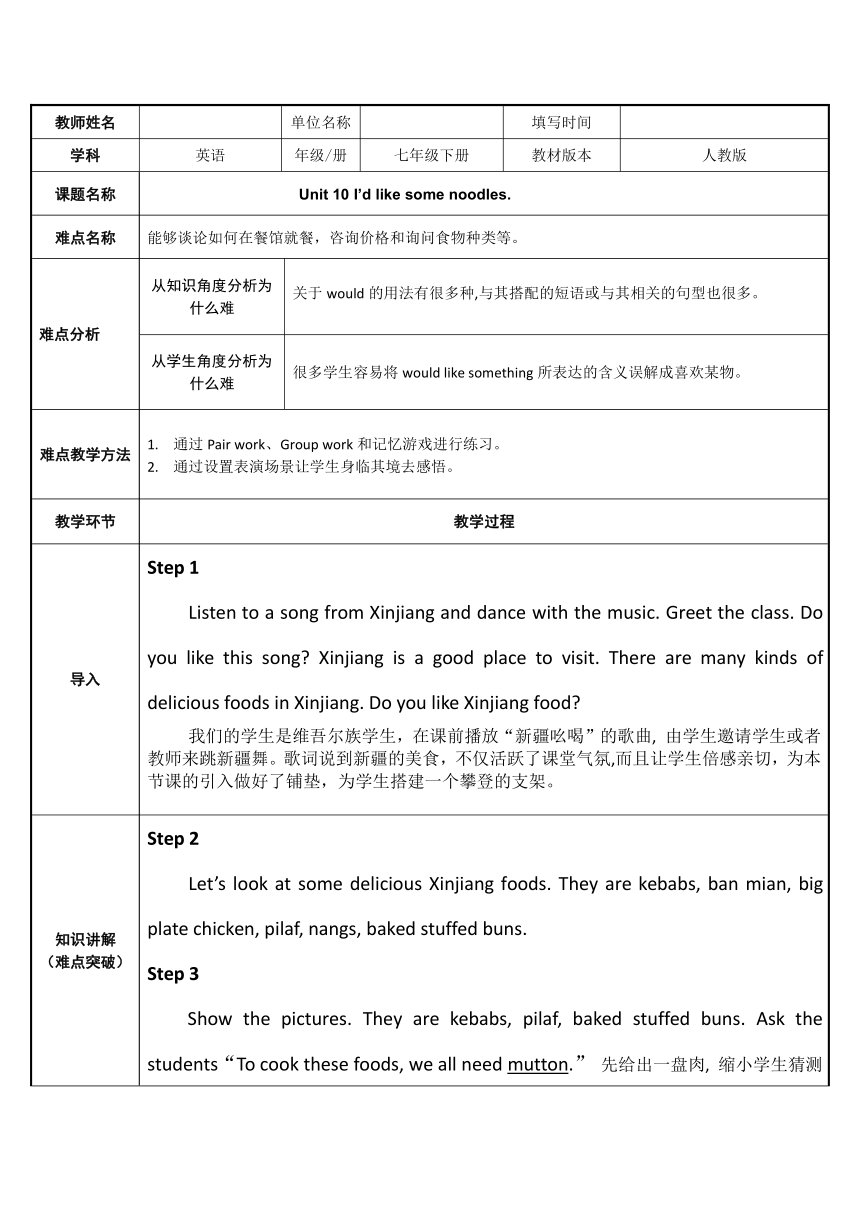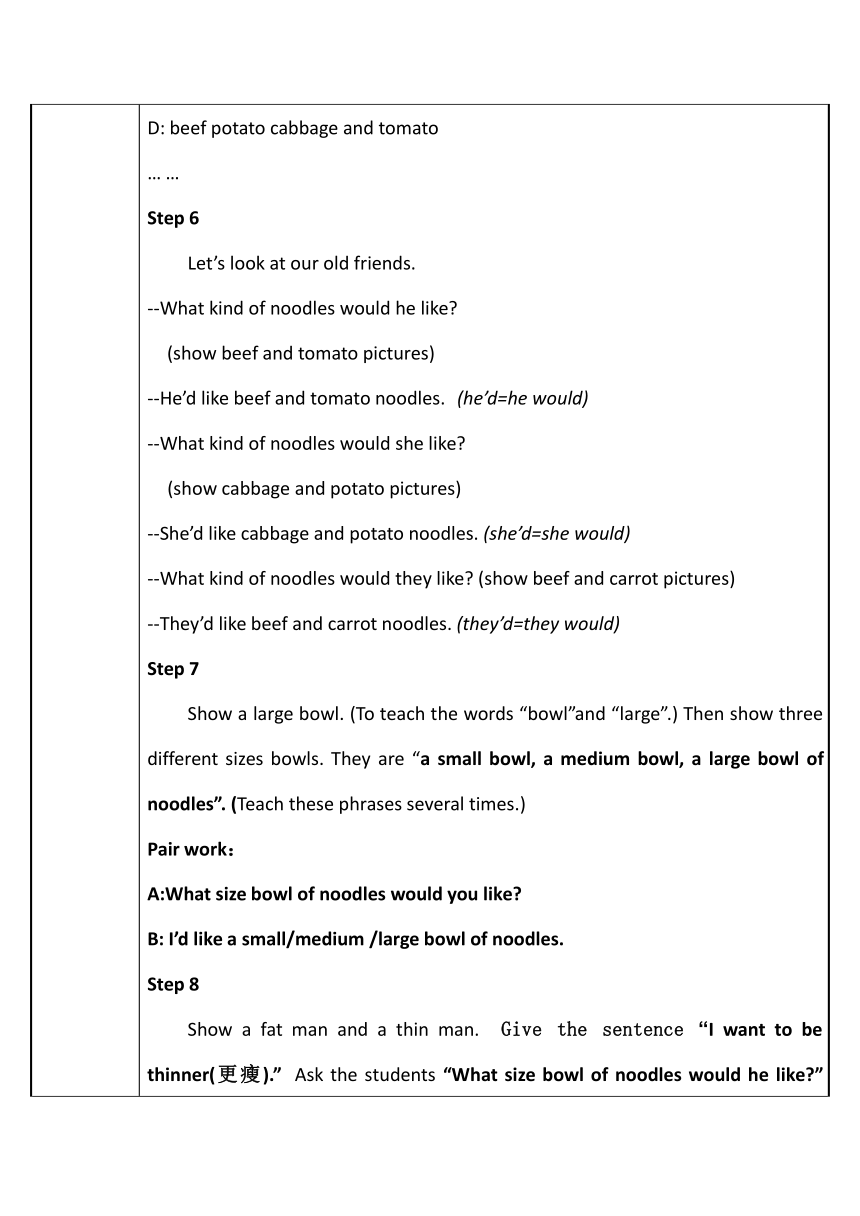人教新目标版七年级下册 Unit 10 I'd like some noodles.(1)教案(表格式)
文档属性
| 名称 | 人教新目标版七年级下册 Unit 10 I'd like some noodles.(1)教案(表格式) |  | |
| 格式 | docx | ||
| 文件大小 | 20.9KB | ||
| 资源类型 | 教案 | ||
| 版本资源 | 人教新目标(Go for it)版 | ||
| 科目 | 英语 | ||
| 更新时间 | 2023-06-16 16:44:10 | ||
图片预览



文档简介
教师姓名 单位名称 填写时间
学科 英语 年级/册 七年级下册 教材版本 人教版
课题名称 Unit 10 I’d like some noodles.
难点名称 能够谈论如何在餐馆就餐,咨询价格和询问食物种类等。
难点分析 从知识角度分析为什么难 关于would的用法有很多种,与其搭配的短语或与其相关的句型也很多。
从学生角度分析为什么难 很多学生容易将would like something所表达的含义误解成喜欢某物。
难点教学方法 通过Pair work、Group work和记忆游戏进行练习。 通过设置表演场景让学生身临其境去感悟。
教学环节 教学过程
导入 Step 1 Listen to a song from Xinjiang and dance with the music. Greet the class. Do you like this song Xinjiang is a good place to visit. There are many kinds of delicious foods in Xinjiang. Do you like Xinjiang food 我们的学生是维吾尔族学生,在课前播放“新疆吆喝”的歌曲, 由学生邀请学生或者教师来跳新疆舞。歌词说到新疆的美食,不仅活跃了课堂气氛,而且让学生倍感亲切,为本节课的引入做好了铺垫,为学生搭建一个攀登的支架。
知识讲解 (难点突破) Step 2 Let’s look at some delicious Xinjiang foods. They are kebabs, ban mian, big plate chicken, pilaf, nangs, baked stuffed buns. Step 3 Show the pictures. They are kebabs, pilaf, baked stuffed buns. Ask the students“To cook these foods, we all need mutton.” 先给出一盘肉, 缩小学生猜测的范围, 再在旁边给出一只羊的图片, 学生就会给出羊肉mutton这个单词。Then show the pictures, they are mutton, potatoes and ban mian noodles. Ask the students “What can we cook with these things ” Help the students to answer “mutton and potato banmian”. Show the pictures. They are noodles, tomatoes and eggs. Use the same way to help the students to say tomato and egg noodles. And tell the students “This is my favorite noodles. That is to say‘If I go to the noodles house, I’d like tomato and egg noodles. (I’d=I would)’”. Use the same way to teach chicken and cabbage noodles, beef noodles. 学习的过程是学生在原有知识和经验的基础上自我建构﹑自我生成的过程。我利用逆向思维,先给出拉拉面的制作图片,并且给出mutton和potatoes,引导学生说mutton and potato ban mian . 接着出示面条的图片, 西红柿和鸡蛋的图片,引导学生说出tomato and egg noodles. 然后再介绍其他种类的面条。 Step 4 Pair work: Show some different kinds of noodles. Make a dialogue with your partner. A: What kind of noodles would you like B: I’d like…noodles. Step 5 Play a game. Do you have a good memory Make a sentence: I’d like ... noodles. A: beef B: beef and potato C: beef potato and cabbage D: beef potato cabbage and tomato … … Step 6 Let’s look at our old friends. --What kind of noodles would he like (show beef and tomato pictures) --He’d like beef and tomato noodles. (he’d=he would) --What kind of noodles would she like (show cabbage and potato pictures) --She’d like cabbage and potato noodles. (she’d=she would) --What kind of noodles would they like (show beef and carrot pictures) --They’d like beef and carrot noodles. (they’d=they would) Step 7 Show a large bowl. (To teach the words “bowl”and “large”.) Then show three different sizes bowls. They are “a small bowl, a medium bowl, a large bowl of noodles”. (Teach these phrases several times.) Pair work: A:What size bowl of noodles would you like B: I’d like a small/medium /large bowl of noodles. Step 8 Show a fat man and a thin man. Give the sentence “I want to be thinner(更瘦).” Ask the students “What size bowl of noodles would he like ” Help them to answer “I think he’d like a small bowl of noodles.” Show a thin girl. Give the sentence “I am very hungry.” Ask the students “What size bowl of noodles would she like ” Help them to answer “I think she’d like a large bowl of noodles.” 在教授“他/她想要多大碗面条”的环节时,首先出示一位fat man,拉出一个箭头, 上面写着“I want to be thinner(更瘦)”, 在旁边出示一位 thin man , 问学生:What kind of noodles would he like 给出句子I think he’d like a…bowl of noodles. 学生会很自然地想到a small bowl of noodles。此种方法图文并茂,形象直观。利用直观教学启迪兴趣,充分调动学生的学习积极性。图文的直观性能使学生产生学习的冲动和兴趣,这样拉近了学生与课文的距离,让学生带着一种轻松自如的心态进入学习。 Step 9 Group work: A: What kind of noodles would you like B: I’d like…noodles. A: What size bowl of noodles would you like B: I’d like a….bowl of noodles. Report like this: I’d like…noodles, I’d like a…bowl of noodles. He’d like…noodles, he’d like a…bowl of noodles. She’d like…/they’d like… Step 10 There is an interesting noodls house. Do you want to go OK! Now let’s enjoy how to make delicious noodles. Play a video. T: Look! They are the specials in this noodles house. What are the specials Let’s have a look. Show specia 1, specia 2, specia 3, specia 4. Step 11 Task: Role- play Order food in a noodles house. T: Imagine you are the waiter in this noodles house, please make a coversation between the waiter and the customer according to these sentences: Welcome to … Can I help you? Yes, please. I’d like some noodles. What kind of noodles would you like What size bowl of noodles would you like I’d like … How much is it, please OK. Here is the money. Thanks! You’re welcome. 我为学生准备了服务员的帽子,学生们以声情并茂的表演方式扮演不同的角色,激发了学生的好奇心和求知欲,加强了学生的跨文化意识的渗透,培养了创新意识。从而将知识﹑能力﹑创新三者统一于情景表演之中。 Step 12 Show a fat boy. Give the sentence “I like French fries, hamburgers and...” Then give the word “unhealthy”. T: Please remember! Eat healthy food to keep healthy! 对学生进行德育教育。 Step 13 Homework: Design healthy breakfast, lunch and dinner for your family. And tell the reasons.
课堂练习 (难点巩固) Group work: A: What kind of noodles would you like B: I’d like…noodles. A: What size bowl of noodles would you like B: I’d like a….bowl of noodles.
小结 本课是人教版新目标英语七年级下册Unit 10 I’d like some noodles.第一课时。本单元的中心话题是要掌握点餐(面条,饮料等的种类及碗的大小)。主要语言结构为:围绕What would you like 等问题,学习“想要什么”的表达。通过本课的学习注重培养学生听、说能力的进一步提高。尤其对于生活中的交际用语起到了积极锻炼的作用,进一步培养学生的跨文化意识和综合语言运用能力,为以后的学习奠定坚实的基础。
学科 英语 年级/册 七年级下册 教材版本 人教版
课题名称 Unit 10 I’d like some noodles.
难点名称 能够谈论如何在餐馆就餐,咨询价格和询问食物种类等。
难点分析 从知识角度分析为什么难 关于would的用法有很多种,与其搭配的短语或与其相关的句型也很多。
从学生角度分析为什么难 很多学生容易将would like something所表达的含义误解成喜欢某物。
难点教学方法 通过Pair work、Group work和记忆游戏进行练习。 通过设置表演场景让学生身临其境去感悟。
教学环节 教学过程
导入 Step 1 Listen to a song from Xinjiang and dance with the music. Greet the class. Do you like this song Xinjiang is a good place to visit. There are many kinds of delicious foods in Xinjiang. Do you like Xinjiang food 我们的学生是维吾尔族学生,在课前播放“新疆吆喝”的歌曲, 由学生邀请学生或者教师来跳新疆舞。歌词说到新疆的美食,不仅活跃了课堂气氛,而且让学生倍感亲切,为本节课的引入做好了铺垫,为学生搭建一个攀登的支架。
知识讲解 (难点突破) Step 2 Let’s look at some delicious Xinjiang foods. They are kebabs, ban mian, big plate chicken, pilaf, nangs, baked stuffed buns. Step 3 Show the pictures. They are kebabs, pilaf, baked stuffed buns. Ask the students“To cook these foods, we all need mutton.” 先给出一盘肉, 缩小学生猜测的范围, 再在旁边给出一只羊的图片, 学生就会给出羊肉mutton这个单词。Then show the pictures, they are mutton, potatoes and ban mian noodles. Ask the students “What can we cook with these things ” Help the students to answer “mutton and potato banmian”. Show the pictures. They are noodles, tomatoes and eggs. Use the same way to help the students to say tomato and egg noodles. And tell the students “This is my favorite noodles. That is to say‘If I go to the noodles house, I’d like tomato and egg noodles. (I’d=I would)’”. Use the same way to teach chicken and cabbage noodles, beef noodles. 学习的过程是学生在原有知识和经验的基础上自我建构﹑自我生成的过程。我利用逆向思维,先给出拉拉面的制作图片,并且给出mutton和potatoes,引导学生说mutton and potato ban mian . 接着出示面条的图片, 西红柿和鸡蛋的图片,引导学生说出tomato and egg noodles. 然后再介绍其他种类的面条。 Step 4 Pair work: Show some different kinds of noodles. Make a dialogue with your partner. A: What kind of noodles would you like B: I’d like…noodles. Step 5 Play a game. Do you have a good memory Make a sentence: I’d like ... noodles. A: beef B: beef and potato C: beef potato and cabbage D: beef potato cabbage and tomato … … Step 6 Let’s look at our old friends. --What kind of noodles would he like (show beef and tomato pictures) --He’d like beef and tomato noodles. (he’d=he would) --What kind of noodles would she like (show cabbage and potato pictures) --She’d like cabbage and potato noodles. (she’d=she would) --What kind of noodles would they like (show beef and carrot pictures) --They’d like beef and carrot noodles. (they’d=they would) Step 7 Show a large bowl. (To teach the words “bowl”and “large”.) Then show three different sizes bowls. They are “a small bowl, a medium bowl, a large bowl of noodles”. (Teach these phrases several times.) Pair work: A:What size bowl of noodles would you like B: I’d like a small/medium /large bowl of noodles. Step 8 Show a fat man and a thin man. Give the sentence “I want to be thinner(更瘦).” Ask the students “What size bowl of noodles would he like ” Help them to answer “I think he’d like a small bowl of noodles.” Show a thin girl. Give the sentence “I am very hungry.” Ask the students “What size bowl of noodles would she like ” Help them to answer “I think she’d like a large bowl of noodles.” 在教授“他/她想要多大碗面条”的环节时,首先出示一位fat man,拉出一个箭头, 上面写着“I want to be thinner(更瘦)”, 在旁边出示一位 thin man , 问学生:What kind of noodles would he like 给出句子I think he’d like a…bowl of noodles. 学生会很自然地想到a small bowl of noodles。此种方法图文并茂,形象直观。利用直观教学启迪兴趣,充分调动学生的学习积极性。图文的直观性能使学生产生学习的冲动和兴趣,这样拉近了学生与课文的距离,让学生带着一种轻松自如的心态进入学习。 Step 9 Group work: A: What kind of noodles would you like B: I’d like…noodles. A: What size bowl of noodles would you like B: I’d like a….bowl of noodles. Report like this: I’d like…noodles, I’d like a…bowl of noodles. He’d like…noodles, he’d like a…bowl of noodles. She’d like…/they’d like… Step 10 There is an interesting noodls house. Do you want to go OK! Now let’s enjoy how to make delicious noodles. Play a video. T: Look! They are the specials in this noodles house. What are the specials Let’s have a look. Show specia 1, specia 2, specia 3, specia 4. Step 11 Task: Role- play Order food in a noodles house. T: Imagine you are the waiter in this noodles house, please make a coversation between the waiter and the customer according to these sentences: Welcome to … Can I help you? Yes, please. I’d like some noodles. What kind of noodles would you like What size bowl of noodles would you like I’d like … How much is it, please OK. Here is the money. Thanks! You’re welcome. 我为学生准备了服务员的帽子,学生们以声情并茂的表演方式扮演不同的角色,激发了学生的好奇心和求知欲,加强了学生的跨文化意识的渗透,培养了创新意识。从而将知识﹑能力﹑创新三者统一于情景表演之中。 Step 12 Show a fat boy. Give the sentence “I like French fries, hamburgers and...” Then give the word “unhealthy”. T: Please remember! Eat healthy food to keep healthy! 对学生进行德育教育。 Step 13 Homework: Design healthy breakfast, lunch and dinner for your family. And tell the reasons.
课堂练习 (难点巩固) Group work: A: What kind of noodles would you like B: I’d like…noodles. A: What size bowl of noodles would you like B: I’d like a….bowl of noodles.
小结 本课是人教版新目标英语七年级下册Unit 10 I’d like some noodles.第一课时。本单元的中心话题是要掌握点餐(面条,饮料等的种类及碗的大小)。主要语言结构为:围绕What would you like 等问题,学习“想要什么”的表达。通过本课的学习注重培养学生听、说能力的进一步提高。尤其对于生活中的交际用语起到了积极锻炼的作用,进一步培养学生的跨文化意识和综合语言运用能力,为以后的学习奠定坚实的基础。
同课章节目录
- Unit 1 Can you play the guitar?
- Section A
- Section B
- Unit 2 What time do you go to school?
- Section A
- Section B
- Unit 3 How do you get to school?
- Section A
- Section B
- Unit 4 Don't eat in class.
- Section A
- Section B
- Unit 5 Why do you like pandas?
- Section A
- Section B
- Unit 6 I'm watching TV.
- Section A
- Section B
- Review of Units 1-6
- Unit 7 It's raining!
- Section A
- Section B
- Unit 8 Is there a post office near here?
- Section A
- Section B
- Unit 9 What does he look like?
- Section A
- Section B
- Unit 10 I'd like some noodles.
- Section A
- Section B
- Unit 11 How was your school trip?
- Section A
- Section B
- Unit 12 What did you do last weekend?
- Section A
- Section B
